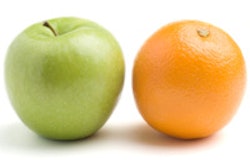
Shrinkage stress is a shortcoming of composite resin restorations that has yet to be solved, so some inevitably perform better than others. A new study has compared the effectiveness of composite resin and resin-modified glass ionomer liners on gingival marginal adaptation of class II cavities that were restored with three different bonding agents along with their respective composite resins.
Concrete results and recommendations arose following the completion of the work by researchers from the departments of conservative dentistry and endodontics at the Jamia Millia Islamia Faculty of Dentistry and Sri Gobind Tricentenary (SGT) Dental College in New Delhi and Gurgaon, India, respectively. "Placement of liners improved the values of 'continuous margin (CM)' in the gingival floor of the proximal cavities restored with composite resins using different bonding agents," the researchers wrote (Journal of Dentistry, March 11, 2014).
After comparing Single Bond (3M ESPE), One Coat Self-Etching Bond (Coltène/Whaledent), and Adper Easy Bond Self-Etch Adhesive (3M ESPE) bonding agents, the researchers found that CM values were more improved with the use of the first two (78 ± 11% and 77 ± 9%, respectively) when compared with a no-liner group, while the last did not improve CM values (61 ± 12%).
Those results and others led the researchers to offer specific advice to clinicians: "Placement of flowable composite liner or glass ionomer liner will improve the marginal integrity of composite restorations using etch-and-rinse and two-bottle, two-step self-etch adhesives," they wrote. And applying glass ionomer liner is an effective way to improve the marginal integrity of a single-bottle adhesive.
To test the effect of flowable composite liners and glass ionomer liners on the gingival marginal adaptation of class II cavities restored with these materials, the researchers started with 90 extracted nonrestored, noncavitated, similar third molars. After preparing a box-only cavity in each, they divided the molars into three experimental groups of 30. Then those groups were divided into subgroups of 10 based on the different bonding agents employed.
Group I had no liner placement and the three different bonding systems were applied for each subgroup. The various bonding systems were applied in group II and, subsequently, the researchers placed a flowable composite liner at the gingival margin. The researchers used Filtek Z350 XT (3M ESPE) flowable resin for the Single Bond and Adper Easy Bond subgroups and Synergy D6 (Coltène Whaledent) flow resin for the One Coat Self-Etching Bond subgroup.
In group III, the researchers applied a liner of resin-modified light-cured glass ionomer, Ketac N100 (3M ESPE). After priming and application, the samples were divided into subgroups so that each product could be utilized.
All the samples were stored for 24 hours and placed in a chewing simulator for 150,000 cycles at room temperature with 100% humidity. Then the gingival margins were examined with a scanning electron microscope to determine if a "continuous margin" or "gapped margin" interface existed.
In group I, 64% of the samples without a liner displayed continuous margin without any significant difference between the subgroups (p < 0.28). The placement of a liner increased the values of CM overall (p < 0.05) in group II, from 68% to 78%, the researchers noted. More specifically, CM values of the Single Bond and One Coat Self-Etching Bond subgroups were significantly improved by the placement of a flowable composite liner compared with the no-liner group (p < 0.05). But the Adper Easy Bond Self-Etch Adhesive CM values were not improved (p > 0.05).
Meanwhile, CM values were increased across the board in group III, in which a glass ionomer liner was placed (p < 0.05), even in the Adper Easy Bond group in which a flowable composite liner failed to produce improved CM values.
"In the present study, the values of CM of One Coat system were similar to the Single Bond system," the researchers wrote. "Single Bond and One Coat self-etch system showed better marginal adaptation than Adper Easy Bond."



















